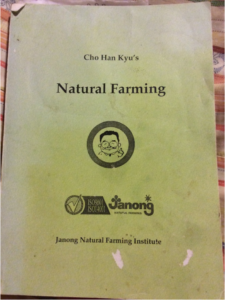- drake answered 8 years ago
- last active 8 years ago
Classes offered by Drake and other instructors are listed at KNF Certification Training Courses page.
Because of the timely nature of this post, please check the list for the most up to date listings.
- drake answered 8 years ago
- last active 8 years ago
A lot of good questions here!
As far as I know, Master Cho has given a prescription to solve the issue of drowning roots by spreading IMO4 and watering with the appropriate soil treatment solution around the drip line extending out 2-4 feet in a donut shape. This area should also be treated with an appropriate mulch to help the microbes dwell here and subsequently improve the air and water flow of the soil.
As I recall, Elaine Ingham was the one recommending to drill holes on the cardinal points and to fill them with cinder and ‘good’ compost.
To answer your questions specifically
what are the measurements/ratio?
I’d follow Master Cho’s potting soil mix
- 30% cinder
- 30% imo4
- 30% leaf mold soil
- 10% biochar
should the two be pre-fermented together and for how long?
“Charging” BioChar before agricultural use is recommended by top experts in the field. I have heard one recommend composting it with at least 2% fish meal or comparable nitrogen source and letting it heat up and naturally cool down. This functionalizes the charcoal and that has many benefits. see Josiah Hunt on Local Natural Farming Inputs
do I add anything else to the mix?
Love. Love must always be added to the mix!
- drake answered 8 years ago
Han-Kyu Cho was talking about potting soil when he was in Papaikou.
It is somewhere buried in this lecture.
I remember distinctly that I was in the back of the building talking with Zach Mermel while he was going over this material.
As best as I can remember
- 30% Leaf Mold
- 30% IMO4
- 30% Cinder
- 10% Biochar
Please find the exact time in the lecture and correct this formula.
- drake answered 8 years ago
- last active 8 years ago
Natural Farming Hawaii has an excellent Guide to KNF Medicine with the recipe and explanations.
The origin of this solution is with Master Han-Kyu Cho and he recalls the situation here:
(The whole KNF Medicine part starts at 2hours38minutes)
 Understanding the origin helps us deepen our scientific understanding of how to use, preserve or modify the recipe based on present circumstances. What makes the KNF Medicine recipe unique in the world of tincturing is the fermentation process that occurs before alcohol is introduced for extraction.
Understanding the origin helps us deepen our scientific understanding of how to use, preserve or modify the recipe based on present circumstances. What makes the KNF Medicine recipe unique in the world of tincturing is the fermentation process that occurs before alcohol is introduced for extraction.
From a merely chemical standpoint, complete tincture can be accomplished in 2 exposures to the material with high proof alcohol. These extractions can then be diluted to reach a similar alcohol content as a traditional recipe. The time and effort saved in this method is significant. However, calculating how much to dilute with water to obtain 1/3 versus 2/3 of new alcohol each time is still an issue.
In a more spiritual aspect, stirring the material every day in the clockwise direction, thinking good thoughts while doing it, putting this much thought and attention into something, following the recipe and dilutions within reason of your intuition has it’s own various benefits that only one who treads the path will discover.
I have seen no justification for the recent attempted modification of the recipe from 2/3 to 1/3. Folks may have individually practical concerns such as affordability, as the original recipe calls for more alcohol which carries significant cost, but this is weighed against the volume of KNF Medicine rendered per usage of herbs which is significantly greater. Individual variance should be allowed as necessary, but the whole recipe should not be changed by any other reason than proven effectiveness.
- drake answered 8 years ago
- last active 7 years ago
If you are talking about the eBook from Natural Farming Hawaii, there should be a link to download the book in your receipt.
There is also a link below the books called downloads and after you log in it will be available there as well.
Hope it all goes smooth for you, and thank you for supporting Natural Farming Hawaii.
- drake answered 7 years ago
- last active 7 years ago
To make a substitute for Brown Rice Vinegar, which is traditionally used in Korea, we have been using banana fruit with the skin on. If you think about the banana, it is like a HUGE rice plant, and the fruits are analogous to brown rice.
In the tropics, I’m pretty sure any fruit can be used to create high quality vinegar that has the effect of alkalinizing the plants.
Banana Vinegar Recipe
Ripe bananas with peels on are mushed into a container, then whatever that volume is, say it’s 1 liter, then double the amount of water added, so 2 liters of water added. This is then allowed to ferment for 3 months at room temperature avoiding sunlight. A ‘mother’ from another living vinegar can be used, or a bit (tablespoon) of braggs living vinegar can be poured in to help the process along.
I believe it can be done in a week time period if you follow a recipe to make fruit alcohol, then leave the alcohol open to the air. I have never done it this way, as mostly what I am using is the dregs left over from making KNF Food by fermenting plant juice, which I then add a bit more sugar to and follow the above recipe.
- drake answered 7 years ago
The ratios will apply to any type of measuring unit whether it be metric or american.
However, if you are looking for quick conversions into metric, like how much to add per liter, I have written a handy app for mobile that will do the calculations on the fly.
As I expand and develop the book more fully, there will be conversion tables as well.
- drake answered 7 years ago
When I am making banana vinegar following this recipe, often times material will float to the surface. The material will grow in to what is called a SCOBY (Symbiotic Colony of Bacteria and Yeast), often also called the ‘mother’ of vinegar. These SCOBY take the form of thick, impenetrable, slimy disks that typically float on the surface.
Even though this material ‘rots’ a little bit, mostly what is happening is fermentation rather than putrefaction which can be detected by observing the (perhaps) pleasant smell versus a repulsive putrid smell. The microbes will slowly be digesting the material into alcohol and then vinegar over a 2-3 month process. The microbes associate with fermentation are often compatible with human health, while the microbes of putrefaction often are pathogenic and disease oriented in nature.
Placing a breathable lid such as a cloth over the container opening will keep bugs out preventing further contamination.
- drake answered 7 years ago
Fermenting plant juice to make KNF Food is done with strictly one plant at a time. Other recipes for making KNF Food from fruits use 3 or more.
The reason for only using one plant material at a time is in the stage of fermentation, to make it as clean and efficient as possible. The microbes colonizing the plant’s surface are designed to digest it and break that specific plant down as it naturally sloughs off cells, so when you mix them with sugar and cause the juice to come through the cell boundary, these microbes do really well. However, if you have multiple plants, the microbes from one plant are really good at digesting their own plant the are only okay at digesting a different plant. When the microbes mix with multiple plants and the resulting fermentation is only so-so.
The best way to combine KNF Food made by fermenting plant juice is to mix the different KNF Food solutions right before using them. So where a recipe calls for 1:500 of KNF Food, I can put in 1:1000 of one plant material and 1:1000 of another plant material. Both of these together will make 1:500 dilution.
The other thing to note is that different parts of the plant correspond with different phases of the plant growth. In the early vegetative stage, it is best to apply KNF Food made from plant tips, as the plant starts to enter puberty, it is best to use KNF Food from flowers, and as the fruit starts to ripen a KNF Food made from fruit will have added benefit.
- drake answered 7 years ago
- last active 7 years ago



